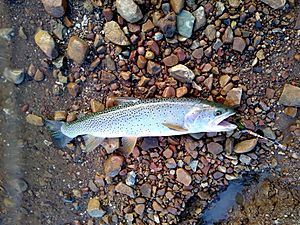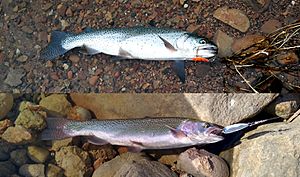Bonneville cutthroat trout facts for kids
Quick facts for kids Bonneville cutthroat trout |
|
|---|---|
 |
|
| Scientific classification |
|
| Kingdom: | Animalia |
| Phylum: | Chordata |
| Class: | Actinopterygii |
| Order: | Salmoniformes |
| Family: | Salmonidae |
| Genus: | Oncorhynchus |
| Species: | |
| Subspecies: |
O. c. utah
|
| Trinomial name | |
| Oncorhynchus clarkii utah (Suckley, 1874)
|
|
The Bonneville cutthroat trout (Oncorhynchus clarkii utah) is a special type of cutthroat trout. It lives in the streams and rivers that flow into the Great Salt Lake in the U.S.A.. Most of these fish are found in Utah, but you can also find them in Idaho, Wyoming, and Nevada. It is one of about 14 different kinds of cutthroat trout found in the western United States.
In 1997, the Bonneville cutthroat became the official state fish of Utah. It replaced the rainbow trout. This fish was very important to the Native Americans and the Mormon pioneers. It was a key source of food for them.
Contents
Where They Come From and What They Eat
Ancient Lake Bonneville
Bonneville cutthroat trout are descendants of fish that lived in a huge ancient lake. This lake was called Lake Bonneville. It existed during the Pleistocene Ice Age. Lake Bonneville covered parts of Utah, eastern Nevada, and southern Idaho.
Over time, Lake Bonneville dried up. It left behind the Great Salt Lake. The Great Salt Lake is too salty for most fish to live in. Only tiny creatures like brine shrimp can survive there.
Living in Smaller Waters
Because the big lake disappeared, Bonneville cutthroats became separated. They now live in smaller groups. You can find them in the upper parts of mountain creeks, streams, rivers, reservoirs, and lakes. These waters are all part of the Bonneville drainage basin. Being separated has made different groups of these fish look a bit different from each other.
What They Eat
Bonneville cutthroat trout mostly eat other fish. They will eat whatever small fish are available in their waters. This can include chubs, gizzard shad, whitefish, or Utah suckers. They might even eat very small bass, walleye, or other trout. This includes the tiny rainbow trout that are often put into mountain waters.
When other fish are hard to find, especially in high mountain lakes or streams, Bonneville cutthroats also eat insects. This makes them a fun fish for people who like to fish with dry flies. These anglers often look for brown trout and brook trout in Utah's streams and rivers.
What They Look Like
The Bonneville cutthroat looks similar to other types of cutthroat trout. It has small, scattered black dots on its upper body. These dots look a bit like pixels.
Colors of the Fish
The colors of a Bonneville cutthroat can change. It depends on where they live.
- Fish from lakes and reservoirs are usually silver-gray to charcoal. Their sides might have soft pink colors. Their backs can be a deep green.
- Fish from rivers often have a much more yellow color. This yellow can be stronger than the pinks and greens seen in lake fish.
Some Bonneville cutthroats, especially those from Bear Lake, might not have the bright red slash under their jaw. This slash is typical of cutthroat trout. Instead, their jaw slash might be yellow, pink, or orange.
Telling Them Apart from Rainbow Trout
It can be tricky to tell a cutthroat from a rainbow trout. Here are some differences:
- Cutthroat trout have special teeth in their throat. These are called basibranchial (hyoid) teeth. They are located between the gill arches and behind the tongue. Rainbow trout do not have these teeth.
- The black dots on a Bonneville cutthroat are usually larger and more spread out than those on a rainbow trout.
- The Bonneville cutthroat also has a larger, more noticeable jawline.
Protecting the Bonneville Cutthroat Trout
The Bonneville cutthroat trout is one of the native fish of the Mountain West. From the 1850s to the 1920s, people fished for them a lot. They were caught for selling and for food. At one time, there were so many that people thought they were a nuisance.
Today, things are different. The Bonneville cutthroat is now on the Utah Sensitive Species List. This means they need special protection.
Spawning and Hybrids
Bonneville cutthroats lay their eggs in the spring. They do this near the mouths of streams, over gravel. The eggs hatch in about 24 to 25 days.
Sometimes, Bonneville cutthroats breed with rainbow trout. This happens because both types of fish live in many of the same waters. When they breed, they create mixed fish called cutbow hybrids.
To keep the pure Bonneville cutthroat strong, the state of Utah tries to protect certain waters just for them. For example, Little Dell Reservoir, which is upstream from Mountain Dell Reservoir, is kept specifically for Bonneville cutthroat trout.



